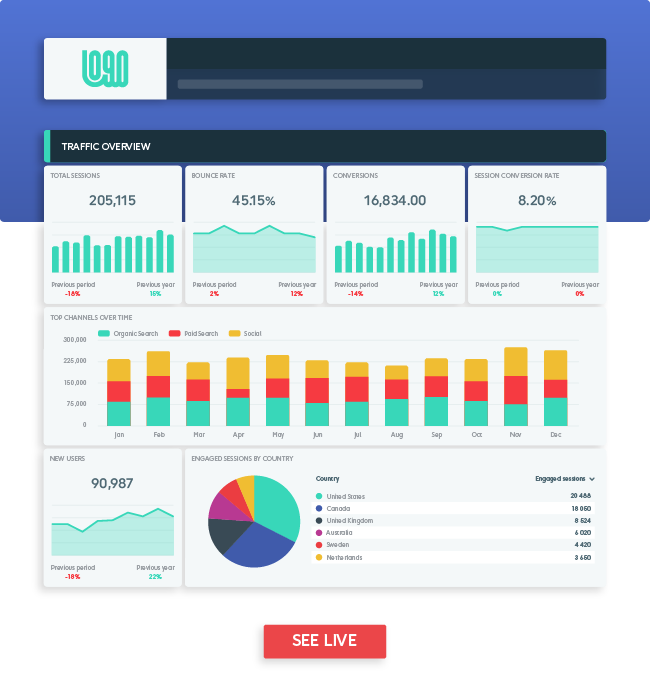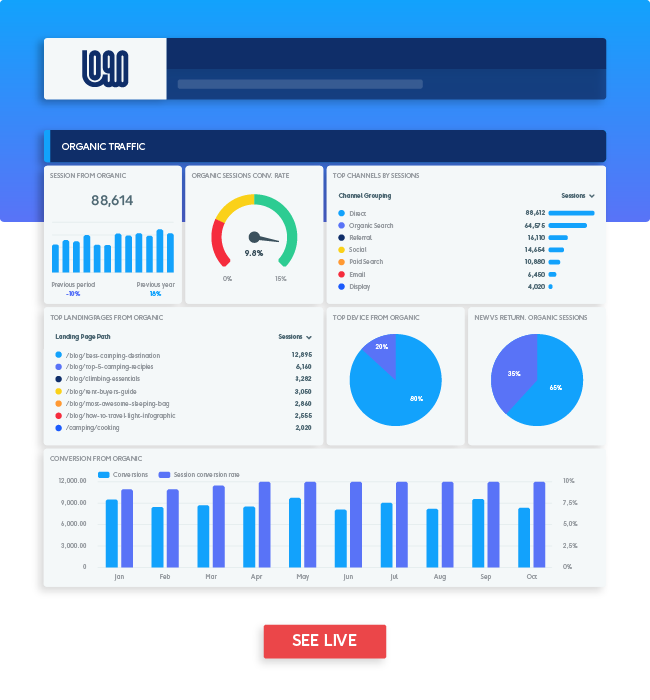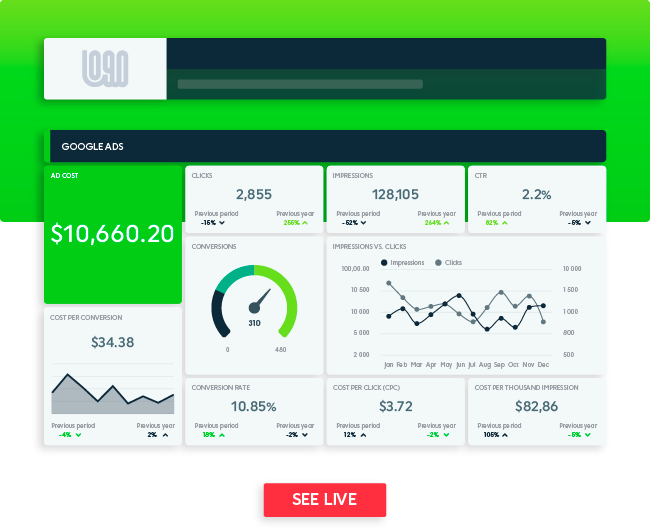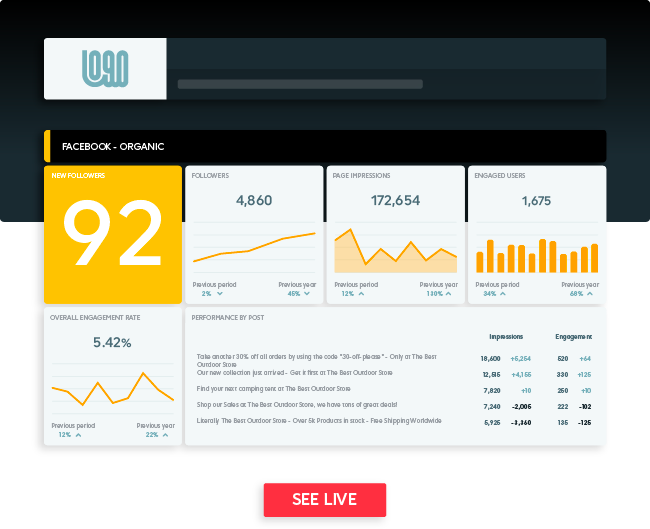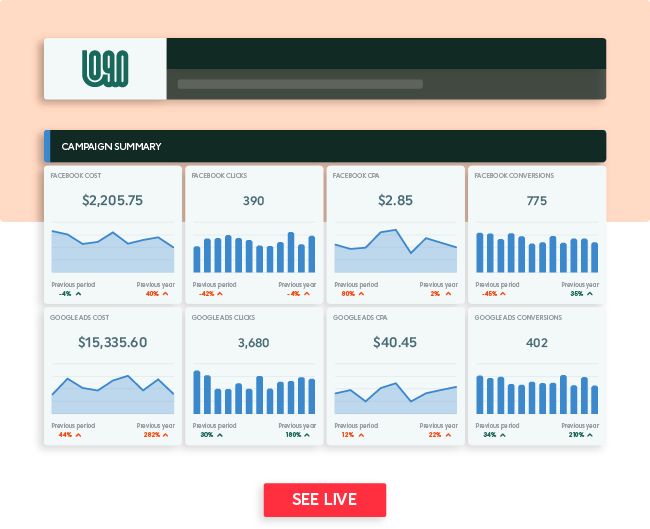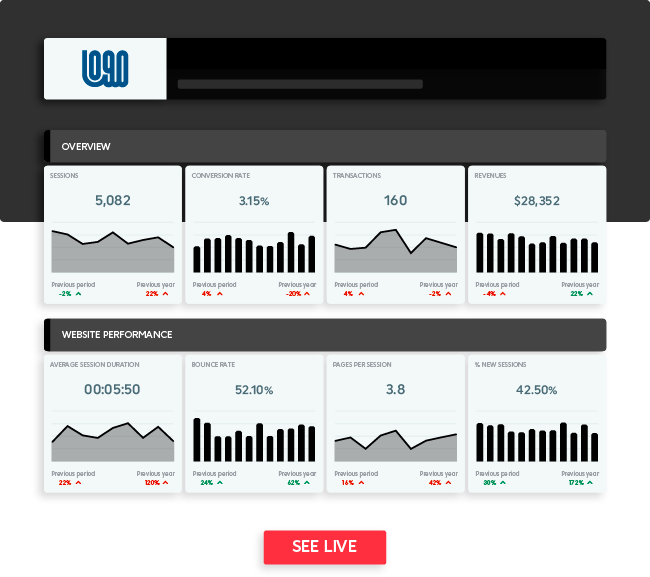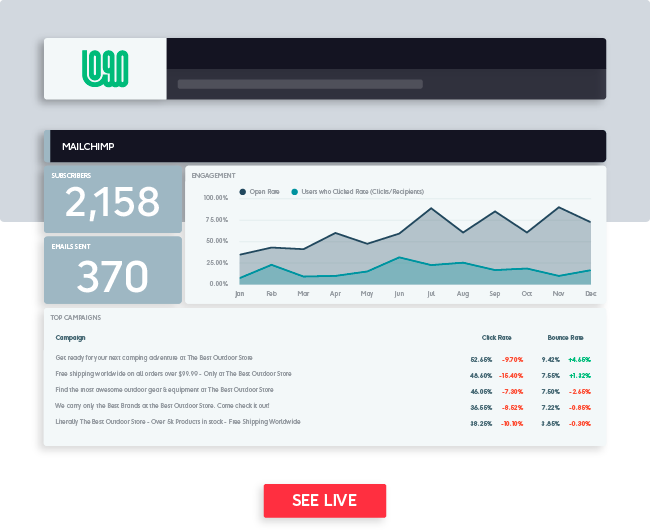7 Marketing Report Templates Every Digital Marketer Needs

If you want to jump straight to the templates, click on the table of contents below.
- General marketing report
- SEO marketing report template
- PPC campaign report template
- Social media marketing report template
- Display advertising campaign marketing report template
- Ecommerce marketing report template
- Email marketing report template
I know you didn’t get into marketing to spend your time creating reports. However, you also know that marketing is ultimately a numbers game:
you can’t optimize what you can’t measure, and you can’t measure without a proper data visualization mechanism.
That’s why marketing reports are so important: they’re your way of proving that the budget you’re putting in place for different marketing activities is positively impacting the bottom line. It’s also a great way to measure progress toward your marketing goals, keep track of your marketing budget, and make data-driven, informed decisions.
Before we plunge into our selection of report templates, let's dive deeper into the world of marketing reports: their importance, the art of creating them, and how often you should analyze them.
What is a marketing report?
A marketing report is a document that combines data from across multiple marketing channels in real-time to show the overall performance results of your global marketing strategy. While the scope of a marketing report can be varied depending on the number of platforms you’re gathering data from and the subject matter (analytics, demographics, social media, SEO, etc.), the purpose is to understand whether your current marketing plan is going in the right direction, as well as how to optimize them. A marketing analytics report is also made to send or share with your marketing team, clients, or stakeholders.
When do you need to make one?
If you’re in marketing, you will want to look at your performance data constantly. Although daily or weekly marketing reports can be helpful, the general rule of thumb for regular marketing reports is to create them every month. In data-speak, a month is a long enough time to gather enough relevant data, but it’s not too long that you miss opportunities or let lower-performing strategies stick around for too long.
What should you include in a marketing report template?
In a marketing report template, it's essential to include key metrics and performance indicators relevant to the goals and objectives of the marketing campaign. This typically involves data on website traffic, conversion rates, social media engagement, email campaign effectiveness, and other pertinent metrics specific to the campaign's focus.
Additionally, incorporating visual elements such as graphs, charts, and tables can help to communicate the data and highlight trends or patterns. Alongside the data, providing analysis and insights into the performance and recommendations for future strategies adds value to the report and helps stakeholders understand the implications of the findings.
Why are marketing report templates so important?
Marketing report templates are crucial tools for streamlining marketing data collection, analysis, and presentation. They provide a structured framework that ensures consistency in reporting across different campaigns and time periods, making tracking progress and identifying trends easier. This saves time and effort and enhances transparency and accountability, ultimately facilitating informed decision-making and driving continuous improvement in marketing strategies and performance.
Top marketing report templates you should be using
The following marketing report examples will provide you with a solid frame on which to build. As you figure out which important metrics you’re using more or which ones you find are missing, you can customize the reports over time according to precisely what makes the most sense to you and your clients.
1. General marketing report template
Try this template with your data!
Regardless of your particular goals for your channel-specific strategies, all your marketing efforts are ultimately geared toward reaching your broader business goals, right?
That’s why you want to start with a general digital marketing report template; this will serve as an overview of all your strategies.
This template will include bits and pieces of marketing data from across your web analytics, SEO, social media, PPC, email, content marketing, and anything else you find crucial to have here.
The point of this type of report isn’t to delve into the details; keeping this as an objective overview is essential. If you want to get into a specific part of your marketing strategy, the following marketing reports offer a more detailed analysis.
2. SEO marketing report template
Try this template with your data
Search engine optimization is integral to every digital marketing manager’s long-term strategy; if PPC, web advertising, email, and social media are the numerous branches of your digital marketing, SEO is the trunk.
Google Analytics, SEMrush, Moz, Ahrefs, Google Search Console, and Google My Business… the tools you use to execute, track, and optimize your SEO strategies can vary. They each have their own specialties and uses, but since you need to see how they ALL serve to aid your global SEO strategy, your SEO report most likely needs to include data from across them all.
What should be included in your SEO marketing report template? Well, you’re probably going to need four main types of KPIs here:
- organic sessions,
- organic conversions,
- organic landing pages,
- and organic keywords rankings.
Across these types, you’ll want to include important marketing metrics such as overall visits from organic, organic conversion rate, top organic keyword by clicks, and more. The point is to show the amount of website traffic your organic efforts bring in, the type of traffic, and what this traffic means for your general bottom line.
If you’d like to include a comparison to non-organic traffic, that can be an excellent addition – although those comparisons could also be on your general marketing report mentioned above.
3. PPC campaign report template
Try this template with your data!
SEO and PPC go together like peanut butter and jelly. Contrary to SEO, the advantage of PPC is that the return on investment is far easier to track and understand in the short term; it’s the simple calculation of “dollar-out, dollar-in.”
Again, there’s a wide range of marketing tools at your disposal for your PPC ad campaigns, the most common of which are Google Ads, Bing Ads, Facebook Ads, and SEMrush.
The perfect PPC campaign report template is all about those clicks and dollars. Again, you’re going to have four overarching themes in this report:
- clicks & cost,
- conversions,
- revenues,
- and ad performance.
To organize these key performance indicators (KPI), it’s often easier to divide your report by channel (Googlr Ads vs. Bing Ads, for example) to make it easier to understand your budget allocation since you’ll want to know which channels are bringing you the most bang for your buck.
4. Social media marketing report template
Try this template with your data!
The number of social media users worldwide is over 3 billion, so it’s a safe assumption to say that there are myriad audiences to reach here.
When we talk about social media marketing, we can either mean through organic means (community engagement and content sharing, for example) or paid channels on those same networks. Although there are many social media platforms around, the most common ones you’ll most likely be using and want to include in your social media report will be Facebook Insights and Ads, Instagram and Ads, Tiktok Ads, and Youtube.
There are again four main types of KPIs in this template:
- likes & followers,
- impression & reach,
- engagement,
- and top-performing posts.
To understand what kind of ROI you’re getting from each of your networks, the ideal social media report template has your data organized accordingly. With sections for each social media channel you use – one for Facebook, one for Instagram, one for LinkedIn, and so on – you can better determine where you need to allocate more time and energy… and where it might not be worth it.
5. Display advertising campaign report template
Try this template with your data!
Display advertising is the internet’s version of the billboard. And it’s often as effective in attracting the eye as its live-version predecessor.
Bring all the datasets from Google Ads, Facebook Ads, and your other display advertising tools into one campaign performance report so that you can optimize your strategy as a whole instead of only seeing it on one platform at a time.
The advertising campaign report template is another one that is best organized by the platform to compare marketing campaigns and pinpoint your highest ROI and where you might need some improvement.
The key metrics that are included in this template touch on the necessities:
- cost,
- clicks,
- conversions,
- click-through rate (CTR),
- and impressions.
Everything you need to make the most of your display ads!
6. Ecommerce marketing report template
Try this template with your data!
Your eCommerce strategy constantly evolves as you develop new products and services and the market changes. This eCommerce marketing report template ensures you have all your KPIs at your fingertips to take advantage of your opportunities as they crop up!
Since eCommerce touches on several aspects of your web presence, your tools will range from Google Analytics and Google Ads to your social media networks and display advertising platforms.
Your eCommerce report might resemble the general marketing report we mentioned above, with more details about eCommerce businesses. As such, the report should start with an overview of your performance, with marketing KPIs such as the number of leads, new customers, sessions, transactions, revenue, and conversion rate.
Since your website's marketing performance directly affects your eCommerce numbers, it’s important to include KPIs such as the percentage of new sessions, bounce rate, and pages per session. You’ll have a report section dedicated to only your eCommerce results: number of transactions, product sales, average order value… this is where you get into the complex numbers.
The last two sections of your eCommerce report are geared to the two ways in which you drive traffic:
- Paid advertising, where KPIs include ROAS, clicks, and cost per transaction.
- SEO, where KPIs include sessions from organic, revenue from organic, and conversion rate.
7. Email marketing report template
Try this template with your data!
Email marketing remains, to this day, one of the most effective parts of digital marketing; you’re landing your campaign directly in your audiences’ hands and front of their eyes. It’s hard to beat that type of targeting.
That’s why an email marketing report template is so important. With such potential at your fingertips, the slightest optimizations in open rate or click-through rate can make a world of difference to your bottom line.
Whether you’re using MailChimp, Klaviyo, Campaign Monitor, Hubspot, or your own internal system that you track with Google Analytics, there are a few KPIs that are non-negotiable:
- number of emails sent,
- unique open rate,
- click rate,
- and overall campaign performance.
You want to know how much of your target audience you reached, whether they were interested enough to open your message, and whether they converted thanks to your campaign.
Marketing report templates give you what you need, quickly!
Depending on the business you or your client are in, you might not need to use every one of these marketing campaign report templates on a regular basis. But having the option at your fingertips is certainly helpful, right?
DashThis automated reporting tool has every one of these marketing dashboard templates (and more!) ready to use. With over 30 built-in marketing integrations and data sources, tons of customization options and functionalities, and an automated email dispatch system that makes sharing your reports with your boss and clients much more accessible, DashThis is the all-in-one reporting tool your marketing agency needs.
And with these templates, creating a report takes all of 5 minutes. Connect your marketing tools, choose the template you need, and BOOM, you’ve got a marketing report ready to share, discuss, and act on! Ditch your Excel or Google Sheets and automate your reporting with Dashthis today!
Ready to get started?
Try our report templates with your own data today!
Read More
Don’t miss out!
Automate your reports!
Bring all your marketing data into one automated report.
Try dashthis for free